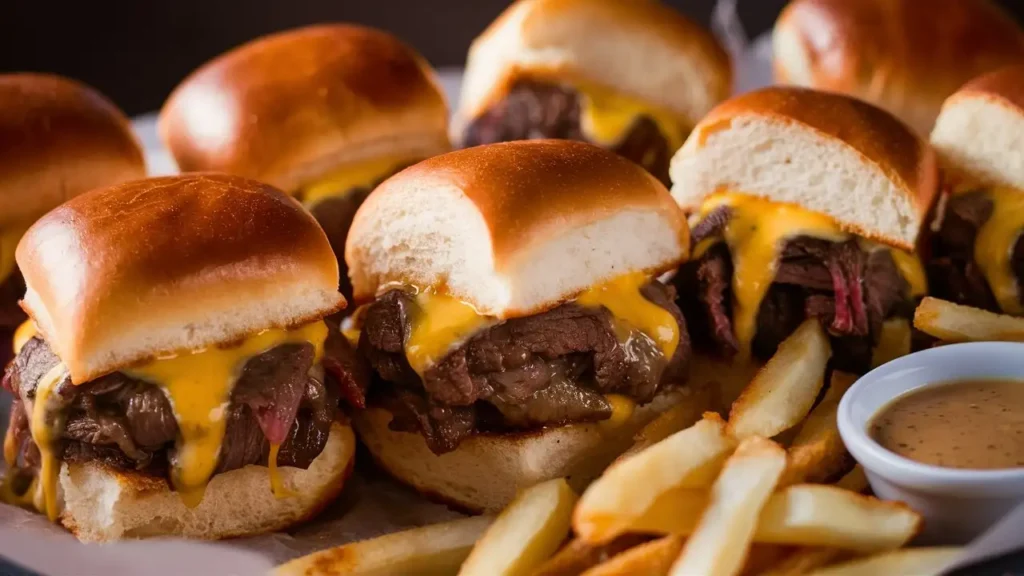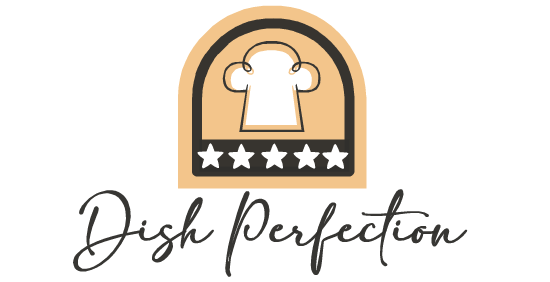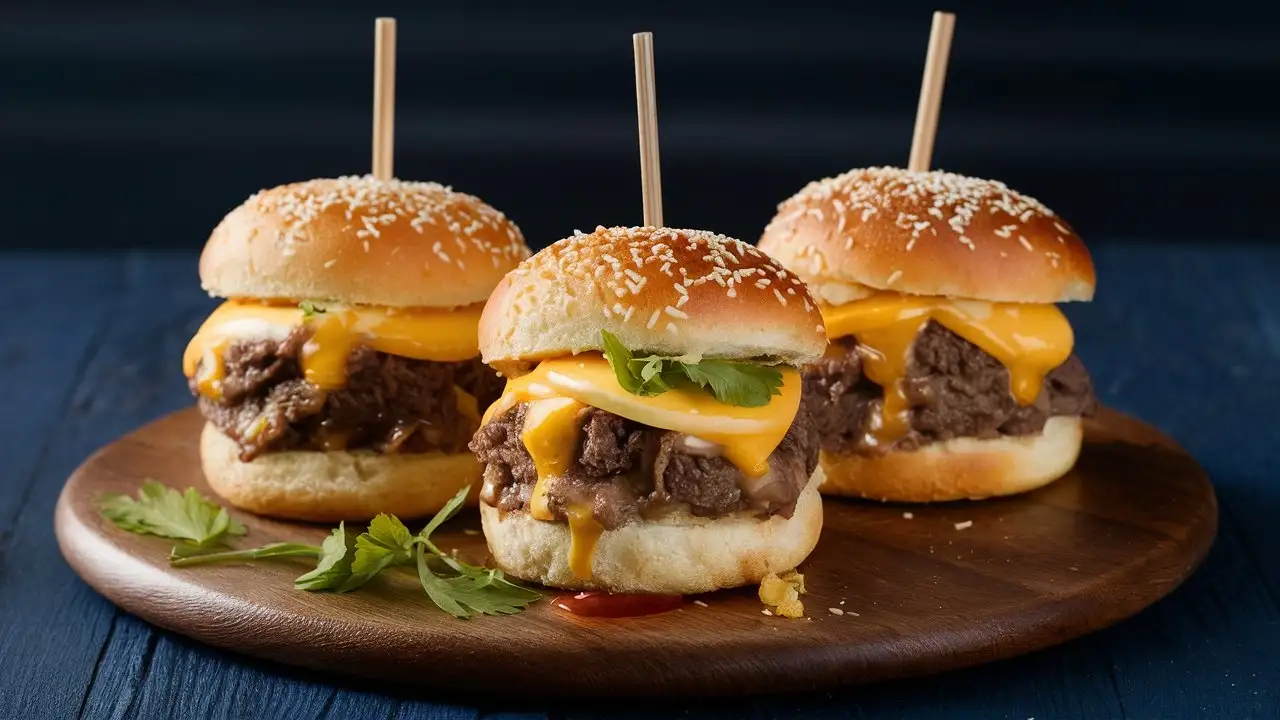Part 1: Introduction to Philly Cheesesteak Sliders
What Are Philly Cheesesteak Sliders?
Philly Cheesesteak Sliders are a miniaturized version of the classic Philly cheesesteak, which is beloved across the United States. These sliders feature thinly sliced ribeye steak, melted provolone cheese, and sautéed onions and peppers, all nestled between soft, sweet rolls. What makes these sliders a fantastic choice for gatherings is their size – perfect for snacking without requiring a sit-down meal.
In essence, these sliders encapsulate the savory essence of a traditional cheesesteak in a bite-sized package, ideal for sharing. Picture the delight of biting into a slider melding tender steak, sharp provolone, and caramelized onions and peppers.
Why They’re Perfect for Any Occasion
Now, why are these sliders just perfect for any event? Well, firstly, they’re incredibly versatile. Whether you’re hosting a Super Bowl Sunday buffet, planning a birthday party, or preparing a family meal, these sliders are a perfect addition. Plus, they’re not just delicious but also convenient to eat, appealing to both kids and adults alike.
Moreover, their preparation doesn’t require any exotic ingredients or complicated techniques. Most of the ingredients are easy to find, and you might already have them in your kitchen! Plus, the sliders can be made in bulk ahead of time and then quickly reheated, ensuring you’re not stuck in the kitchen when your guests arrive. Also, their appeal is universal; who doesn’t love a good cheesesteak?
Transitioning from what makes these sliders a go-to choice, let’s delve into the essentials of crafting these delectable treats. In the next section, we will explore the ingredients and tools you’ll need to bring these sliders to life. This is where the magic starts, and trust me, once you make these, they’ll become a staple at your gatherings!
Part 2: Ingredients and Preparation
Key Ingredients for Authentic Taste
To whip up authentic Philly cheesesteak sliders, you’ll need a selection of key ingredients that fuse together to create a flavor explosion. Let’s break down these essential components:
- Ribeye Steak: The star of the show is the ribeye steak, renowned for its marbling and flavor. For the best results, opt for fresh, thinly sliced ribeye. This cut cooks quickly and melds beautifully with the other ingredients, providing a tender and juicy base for your sliders.
- Provolone Cheese: A slice of provolone cheese adds the perfect touch of creamy, melty goodness. Its mild yet distinct flavor complements the meat without overpowering it.
- Onions and Green Peppers: Sautéed to perfection, these veggies add a hint of sweetness and a crunchy texture that contrasts delightfully with the softness of the meat and cheese.
- Sweet Rolls: Choose soft, sweet rolls that will hold up to the juiciness of the filling without becoming soggy. The slight sweetness of the buns pairs perfectly with the savory ingredients inside.
Recommended Equipment for Making Sliders
Having the right tools can make the process of creating Philly cheesesteak sliders much smoother. Here’s what you’ll need:
- Sharp Knife: For thinly slicing the steak, a sharp knife is crucial. It allows precision cutting without shredding the meat, preserving its quality.
- Skillet: A large skillet is ideal for sautéing the vegetables and cooking the steak, ensuring everything is evenly cooked.
- Baking Sheet: Crucial for assembling and baking the sliders, a quality baking sheet streamlines the process, allowing you to manage all the sliders at once with ease and efficiency.
Armed with these ingredients and tools, you’re set to create sliders that will tantalize the taste buds and leave your guests craving more. Each ingredient plays a crucial role in building the complex flavors characteristic of a Philly cheesesteak. Next, we’ll dive into the step-by-step guide that will take you from prep to perfection. Whether you’re a seasoned chef or a kitchen novice, these straightforward instructions will help you master the art of making sliders that are both delicious and visually appealing.
Part 3: Step-by-Step Cooking Guide
Preparing the Steak
The first step in creating your Philly cheesesteak sliders is preparing the steak, which is the centerpiece of this dish. Here’s how to do it right:
- Freeze the Ribeye Slightly: If your ribeye isn’t pre-sliced, a little trick to make slicing easier is to freeze the steak for about 30 minutes. This firmness allows you to slice it very thinly, which is ideal for quick cooking and tender eating.
- Slice Thinly: Using a sharp knife, slice the ribeye into thin strips. Thin slices ensure that the steak cooks quickly and remains tender, blending seamlessly with the other ingredients.
- Season Well: Season the steak strips with salt, pepper, and a dash of Worcestershire sauce for that deep, savory flavor that complements the cheese and veggies.
Assembling the Sliders
Once your steak is ready, it’s time to assemble the sliders:
- Prepare the Veggies: Sauté onions and peppers until caramelized, enhancing sweetness and adding crucial flavor to sliders.
- Cook the Steak: Add the sliced steak to the skillet and cook it until it’s no longer pink. Make sure to keep the pieces moving in the pan to cook evenly and prevent them from clumping together.
- Assemble on Rolls: Slice your sweet rolls in half without separating them into individual buns. Lay the bottoms side by side on a baking sheet. Spread the cooked steak and veggie mixture evenly over the roll bottoms, then top each with a slice of provolone cheese.
Baking and Finishing Touches
The final steps will bring your sliders together with a golden touch:
- Top and Cover: Place the top halves of the rolls onto the sliders. Melt some butter and mix in a little more Worcestershire sauce and a sprinkle of dried thyme. Brush this mixture over the top of the rolls to add flavor and help them turn golden in the oven.
- Bake to Perfection: Bake the sliders in a preheated oven at 400 degrees Fahrenheit for about 15-20 minutes or until the cheese is bubbly and the tops are golden brown.
- Serve Warm: These sliders are best served warm, allowing the cheese to be gooey and the bread slightly crispy.
By following these steps, you will ensure that your Philly cheesesteak sliders are a hit at any gathering. Every element, from the steak to the cheese and rolls, crafts a crowd-pleasing dish. Next, we’ll discuss serving tips for an enhanced dining experience..
Part 4: Serving and Pairing
How to Serve Philly Cheesesteak Sliders
Once your Philly cheesesteak sliders are hot out of the oven and smelling irresistible, it’s time to think about the best way to serve them. Here are some tips to make sure your sliders are the star of the show:
- Presentation: Arrange the sliders on a platter lined with parchment paper for easy cleanup. Garnish around the platter with some fresh herbs or a sprinkle of sesame seeds on the buns for an extra touch of flair.
- Keep Them Warm: If you’re not serving the sliders immediately, cover them loosely with aluminum foil to keep them warm. A warming tray can also be handy to maintain the perfect temperature without drying out the buns.
- Easy Access: Make sure to set out plates, napkins, and any extra condiments nearby so guests can help themselves without hassle. Serving them as part of a buffet line might be ideal to encourage guests to mingle and choose their sides.
Perfect Pairings with Sliders
The versatility of Philly cheesesteak sliders means they can be paired with a variety of sides. Here are some crowd-pleasers that complement the flavors of the sliders:
- Crispy Fries: Whether you opt for classic French fries, sweet potato fries, or even curly fries, the crisp texture makes a great contrast to the soft, savory sliders.
- Fresh Salads: A light, fresh salad can balance the richness of the cheesesteak. Consider a Caesar salad, a garden salad with vinaigrette, or a coleslaw for some crunch.
- Pickle and Pepper Tray: Offer a tray of pickled vegetables and mild to hot peppers for guests who enjoy a bit of tang and spice with their sliders.
Remember, the key to great pairings is balance. You want to complement the sliders without overwhelming their flavors. For instance, the crispiness of the fries provides a nice texture contrast, while the freshness of a salad cuts through the richness of the meat and cheese.
Up next, we’ll explore how you can customize your sliders to accommodate different dietary preferences and explore creative variations to keep your menu exciting. Stay tuned for inventive ideas that ensure everyone at your table is delighted.

Part 5: Customizing Your Sliders
Dietary Adaptations for Philly Cheesesteak Sliders
Philly cheesesteak sliders are a beloved classic; nevertheless, they can be adjusted to accommodate various dietary needs.. Here’s how you can adjust the recipe to be inclusive of all your guests:
- Gluten-Free Options: Swap out the traditional rolls for gluten-free buns, or better yet, serve the cheesesteak in lettuce wraps for a low-carb alternative.
- Lactose-Free Cheese: Use lactose-free provolone or mozzarella to cater to those with dairy sensitivities without sacrificing the gooey cheese element that makes these sliders a hit.
- Vegetarian Variation: For a meat-free version, you can replace the steak with portobello mushrooms or seitan, seasoned in the same way as the steak. This substitution provides a satisfying texture and flavor that still feels hearty.
Creative Variations on the Classic Slider
Once you’ve mastered the traditional Philly cheesesteak slider, why not get creative with some variations? These twists on the classic can add excitement to your menu and offer something new for repeat guests:
- Spicy Cheesesteak Sliders: Add jalapeños or chili flakes to the sautéing veggies or into the meat while cooking for a kick that spice lovers will appreciate.
- BBQ Philly Sliders: Mix some BBQ sauce into your steak as it finishes cooking for a sweet and tangy flavor that pairs wonderfully with the savory ingredients.
- Breakfast Cheesesteak Sliders: Top the steak with a fried or scrambled egg for a hearty breakfast or brunch option that’s sure to impress.
Experimenting with variations sharpens skills, catering to diverse tastes, making sliders perfect for any gathering
Next, we’ll move into some commonly asked questions about preparing and serving Philly cheesesteak sliders, providing answers that will help you ensure every batch is as perfect as can be. This FAQ section will cover practical tips and insightful advice to elevate your slider game.
Part 6: Frequently Asked Questions
What is the secret ingredient in Philly cheesesteak?
While there isn’t a universal secret ingredient for Philly cheesesteak sliders, many aficionados swear by a dash of Worcestershire sauce or a sprinkle of garlic powder during the cooking process. These add depth and a hint of umami that elevates the flavor profile of the traditional cheesesteak, making it truly stand out.
What is the best melting cheese for cheesesteaks?
Provolone is the classic choice for an authentic Philly cheesesteak experience due to its excellent melting properties and mild flavor, which doesn’t overpower the taste of the steak. Some prefer American cheese for its creaminess or Cheez Whiz for a gooier texture and sharper taste. Each cheese offers a different nuance to the cheesesteak, so the best one really depends on personal preference.
What is traditionally on a Philly cheesesteak?
Traditionally, a Philly cheesesteak is made with thinly sliced ribeye steak, melted cheese, and sautéed onions. Some variations include green peppers or mushrooms, but purists might argue that these additions are not part of the original Philly recipe. The ingredients are piled onto a long, crusty roll that soaks up all the flavors.
What’s the difference between a cheesesteak and a Philly cheesesteak?
The main difference lies in the regional specificity and authenticity of the ingredients. Above all, a Philly cheesesteak is specifically made with certain ingredients and methods that are traditional to Philadelphia. Also, a regular cheesesteak may vary in bread, cheese, or toppings from the traditional Philly style.. Essentially, all Philly cheesesteaks are cheesesteaks; however, not only all cheesesteaks qualify as Philly cheesesteaks.
These FAQs provide valuable insights into the nuances that define a true Philly cheesesteak and how it differs from similar dishes, ensuring you can appreciate and replicate this beloved classic with authenticity and flair.

